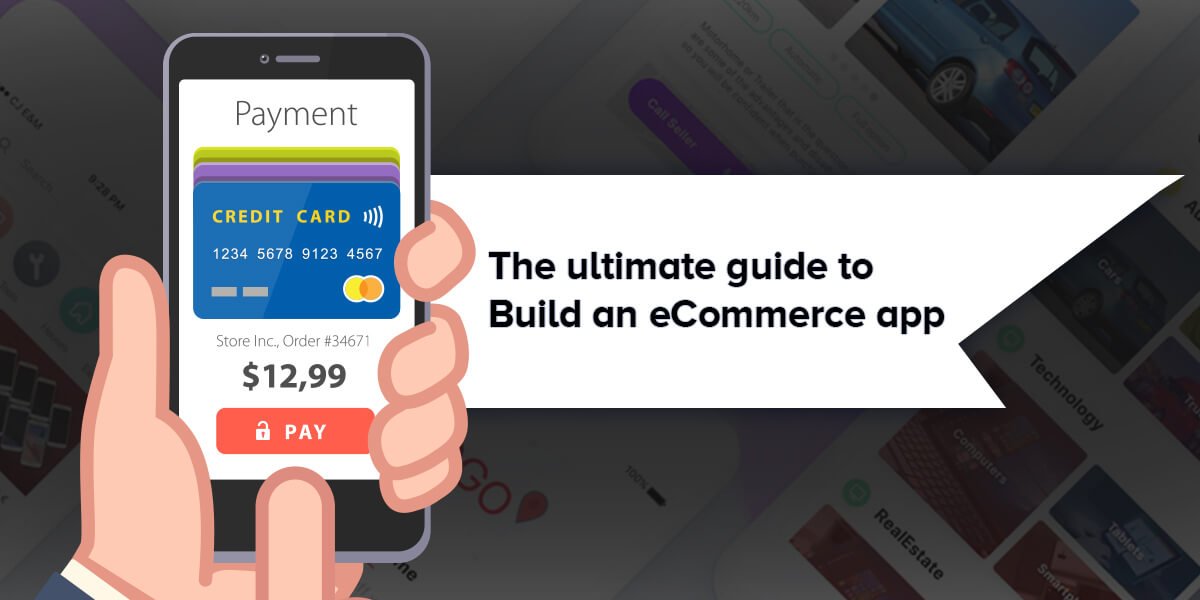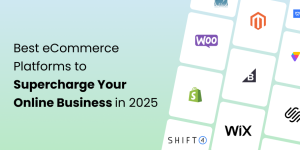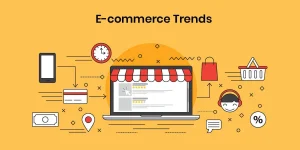How to Build an eCommerce App [A Step-By-Step Guide]

The eCommerce industry is rapidly growing with the launch of smartphones and other gadgets.
Moreover, people love to purchase many things online, such as food, clothing, accessories, and more. In short, an eCommerce app has become a go-to option for users worldwide to purchase things.
Now, let’s have a look at the recent eCommerce statistics:
- According to IMARC Group, the global mobile commerce market was valued at $628 billion in 2020. It will increase at a CAGR of 34% between 2021-2026.
- As per eMarketer, transactions happening on mobile devices will account for 10.4% of overall retail sales by 2025. The number is almost double of 2021, which was 5.9%.
The above statistics indicate that mobile apps are the future of the eCommerce industry. Besides this, there are major benefits of having an app, such as better sales, better customer engagement, etc.
Due to this, numerous startups, entrepreneurs, SMEs, and enterprises have joined the eCommerce bandwagon by developing an eCommerce app.
However, before moving ahead one common question that appears in your mind is how to build a successful eCommerce app.
In this blog, we will provide a complete guide to build an eCommerce app effectively and efficiently.
10 Easy Steps To Build An eCommerce Application From Scratch
Follow steps given below to build a successful eCommerce app easily.
Step 1: Clarify Your Ecommerce App Goals
You should be clear in your mind about why you are building an e-commerce app and what kind of benefits it would provide to your retail business.
Initially, you might have a proper idea about your eCommerce app. In this step, you need to define your eCommerce app idea in brief, considering how digital transformation in ecommerce could enhance your app’s features and capabilities. In this step, you need to define your eCommerce app idea in brief.
Primarily, six types of eCommerce apps are popular in the market. Your idea might fall under these options. Check them below:
- Business to Consumer (B2C) eCommerce app
- Business to Business (B2B) eCommerce app
- Business to Government (B2G) eCommerce app
- Business to Business to Consumer (B2B2C) eCommerce app
- Consumer to Consumer (C2C) eCommerce app
- Consumer to Business (C2B) eCommerce app
It doesn’t matter what kind of eCommerce app you want to develop; you should be able to summarize your eCommerce app idea.
For this, you need to answer some essential questions:
- What is the primary purpose of your eCommerce app?
- What are the current & future goals of your eCommerce app?
- How does this app will allow you to increase sales?
- What are the main issues you want to solve with your eCommerce app? etc.
By asking relevant questions & finding answers, you will get a complete overview of building an eCommerce app.
Also Read: Ecommerce Business Plan for Startups
Here we have listed some unique e-commerce business ideas including the following:
- AR/VR headsets and accessory stores.
- Smart Home products and accessories.
- Online learning platforms.
- Niche subscription boxes.
- Online grocery and foods.
- Pet foods.
- Wedding goods and more.
Want to Build Your Dream eCommerce App?
We will help you turn your eCommerce aspirations into reality. Build your
own high-performing eCommerce app to expand your business reach.
Step 2: Identify Your Target Audience
The next thing you need to identify before developing an eCommerce app is who your target audience is. Here, you need to check whether there is a demand for your eCommerce idea. The best way to validate your idea is create a prototype, this will help you to test your idea at minimum investment.
Consider some of the upcoming app features and identify who can take advantage of your app.

Moreover, it is said that the identification of the niche audience is the first step to making your eCommerce app successful in the market.
To identify the target audience, you have to create a user persona that includes age, gender, location, status, and interests.
Step 3: Analyze Market Competition
There is huge competition in the eCommerce world. To analyze market competition, you need to look at your direct & indirect competitors in the market such as Google Play Store, Apple App Store, and magazines on mobile commerce. Additionally, Selecting the top eCommerce platforms is essential for staying competitive and effectively connecting with your target audience.
You need to identify things about your competitors that WOW users, what tools they use, and the time they took to become successful in the eCommerce industry.
Based on your competitor analysis, you need to list out key features of the eCommerce app that helps you stay ahead of your competitors and reach your target audience efficiently.
If you are in a retail business, then it is essential to ensure that you have products for every age and income group. This will increase the crowd size for your business, which ultimately increases the ROI of your community.
Step 4: Define Key Features for eCommerce App
Based on target audience needs and your business goals, you need to identify all the features of your eCommerce app.
Here, we will provide you with a list of the most crucial features that you shouldn’t miss while developing an eCommerce app.
- User onboarding
- Authorization
- User profile
- Multiple payment systems
- Rate, comment, and review products
- Push notifications
- Quick checkout
- Wishlist
- Admin panel
Step 5: Choose The Right Mobile App Development Platform & Approach
Choosing the right app platform & development approach plays a vital role in making an eCommerce app successful.
Earlier, there were various types of mobile app platforms available in the market such as Android, iOS, Symbian, Microsoft, etc. Out of all, only two types of mobile app platforms are popular in the market right now: Android and iOS.
Also, every small to big business is an option for Android & iOS. Hence, it’s suggested to go with any one of them.
After choosing the platform, the next important thing is to decide on the app development approach. Basically, there are two main types of app development approaches, native and cross-platform.
Using native app development, you can develop an app for a single platform only. While in the case of cross-platform app development, you can build an app that works on multiple platforms (for example, android and iOS) simultaneously.
To know in detail, you can refer to this short guide on the native vs hybrid app.
As you are entering into the eCommerce app market, it is quite tempting for you to build an eCommerce app for every single platform available in the market.
However, if you are a small firm, then it would not be economically viable for you.
Additionally, it has been observed that a focused approach in marketing yields the best results.
You need to figure out which mobile platform is used majorly by your targeted audience. Based on this analysis, you can build an eCommerce app on that platform that offers you a better ROI.
You can go with one platform (Android or iOS) if you are low on budget. Besides this, if you have decided to build an app on both platforms at a cost-effective price, you can go with cross-platform frameworks like Flutter or React Native.
Develop an App to Empower Your Online Business!
Maximize your eCommerce potential by building a feature-rich app. Harness
the power of technology to scale your business and attract new customers.
Step 6: Create a Visually Appealing eCommerce Design
After choosing the right eCommerce app features and the monetization model, designing an eCommerce app in the right way is essential to making your mark in the industry.
Generally, UI/UX app design means knowing your target audience’s behavior and serving them in the best possible manner.
We have done thorough research and found some of the points you should follow and not follow for designing an eCommerce app.
Follow These Things for eCommerce App Design
- Make the app simple to use and avoid cognitive load.
- Research on how the user makes use of the app and design it in such a way that it helps the user to navigate the application
- Remove excess clutter from your app design. It will not only improve the user flow but will also make the app faster to load.
- Insert a user navigation button as it allows users to visit any part of the app quickly and accurately.
- One of the best mobile app design practices is that your design should be fingertip touch-friendly. In other words, the buttons in your app should be big enough to see and touch on your smartphone.
- Focus on the first-time experience through cute animations and attractive images.
- Many mobile app designers don’t focus on personalization; this can lead to a negative impact on the overall UX.
Avoid these things in eCommerce App Design
- Do not mix your UI and UX for a mobile design. While the UI is how an individual interacts with the app, the UX means how he feels about the interaction.
- You will find that many applications have low-contrast fonts and layouts, which make it hard to see the content clearly.
- Many applications do not have a feedback mechanism inbuilt in their design. Initially, this affects the users’ perception of the professional attitude of your company. Moreover, you will not be able to get suggestions that would help you make your app more functional and efficient.
Always take help of mobile app design company to create an elegant and easy to use app designs at economic prices. If you hire freelancer or do it on your own, you will have to pay more in a long run.
Step 7: Develop Your eCommerce App
One of the most crucial stages is turning the design into a real working product and building an eCommerce app.
Front-end developers work on the client side of the application and are responsible for a captivating user experience. In comparison, backend developers work on API and database development and are responsible for prioritizing security, scalability, and efficiency.
In this stage, developers focus on implementing the app’s functionality and integrating payment gateways and other third-party tools.
Instead of implementing a full-fledged product, it is recommended to build an MVP app. It consists of all the essential eCommerce app features and allows testing on real users. You can get feedback instantly and improve your app to make it successful in the long run.
Moreover, if you need help in choosing the right development approach and technology stack, you can contact an ecommerce app development company. They have a team of professionals who can help you and ensure to deliver optimal performance.
Step 8: Testing Your App
Testing your eCommerce app is crucial before putting it into the market. While testing an eCommerce app, you need to look after many essential aspects such as the user experience, responsiveness, navigation, data security, loading time, payment gateway, and secure transaction.
Here, you need to conduct functional, integration, user, and device testing to identify errors in the eCommerce app and correct them instantly. Here, it is suggested to conduct some rounds of testing to ensure that all the things work as needed.
Build Your eCommerce Empire by Launching an App!
Seize the opportunity to dominate the eCommerce market by launching
your own app. Begin your app-building journey now.
Step 9: Launch Your eCommerce App
After testing and making your eCommerce app bug-free, it’s time to launch your app on the relevant platform.
But, before you launch your eCommerce app, you need to go through the app store guidelines. Based on these guidelines, you need to keep ready all the things needed for submitting your app to the store.
When you possess essential things like screenshots, app description, short videos, etc., you can submit your app to the required store on time. Later, an app store approves your app within a period of two weeks.
Also Read: Perfect guide on, how to launch a mobile app successfully?
Step 10: Choose a Suitable App Marketing Strategy
Building an eCommerce app is only one part of increasing the business footprint of your company online.
You have to market it well so that it succeeds in attracting a number of people to download and use it on their smartphones.
Marketing of an app can be done using different marketing strategies, some of which are mentioned below for your reference.
Landing Page:
Make a landing page for your app that consists of the core information regarding your app like the name, features, call to action, and promotional videos to attract the users to download that app. You need to do digital marketing for this landing page to achieve results faster.
ASO(App Store Optimization):
Rank your eCommerce app higher on the app stores. You can do this through App Store Optimization.
Social Media:
Try to create viral video content for your eCommerce app. Then you can share it on social media to reach out to the target audience who will use your app.
Final Words
Lastly, you have now understood all the essential aspects required to build an eCommerce app.
Now, if you have a unique idea or want to convert your existing business into an eCommerce app, then you are on the right path. Here, don’t forget to provide a personalized experience to your audience and a smooth online shopping experience for users.
Lastly, to build an eCommerce app, you will require a team of professionals, consisting of a project manager, backend development, mobile app developer, Q/A tester, etc.
GuruTechnolabs provides eCommerce development services and possesses a highly qualified team of professionals. Our team understands your business thoroughly and provides the best eCommerce app solution at a cost-effective price. If you want to build an eCommerce app, contact us for free consultation.
Frequently Asked Questions
It depends on the product requirements and the goals you wish to achieve through the app. Creating a minimum viable e-commerce app may take 2 to 3 months. Developing a fully functional and feature-rich app takes 5 to 6 months. This is not the end of the road; further, improvement is required.
There is no fixed price to build an eCommerce mobile app as many factors are involved that go into the total cost of the app. However, if you are making a native Android eCommerce app, the cost would be between $10,000 to $50,000, including the design and development charges, the app store registration cost, and the annual App Store fees. The cost of creating a native IOS eCommerce mobile app could be $15,000 to $70,000. To build a hybrid app, you must pay between $10,000 to $100,000 for both platforms.
The systematic approach is the best way to build an eCommerce app. You must use Analytics to find out what type of Smartphone most of your customers use. For example, if most of your customers are using iPhones, you should build a native iOS app to engage with them more effectively. On the other hand, if they are using Android smartphones, it makes sense to create a native Android app to target them better. However, if you want to target both Android and IOS smartphone users, you should invest in a cross-platformapp that can efficiently run on both platforms without any issues at lesser cost.





















